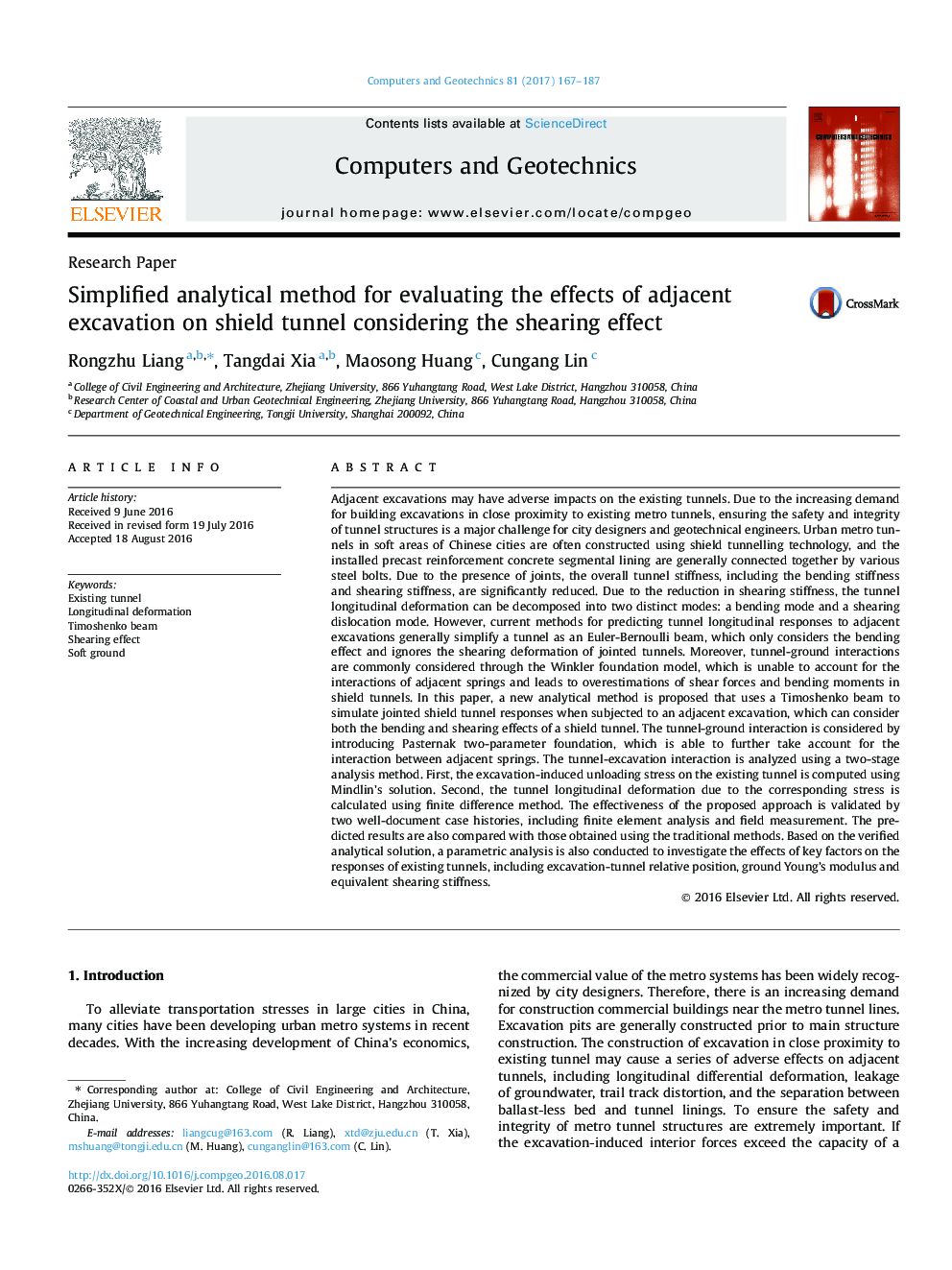| کد مقاله | کد نشریه | سال انتشار | مقاله انگلیسی | نسخه تمام متن |
|---|---|---|---|---|
| 6710111 | 503307 | 2017 | 21 صفحه PDF | دانلود رایگان |
عنوان انگلیسی مقاله ISI
Simplified analytical method for evaluating the effects of adjacent excavation on shield tunnel considering the shearing effect
ترجمه فارسی عنوان
روش تحلیلی ساده برای ارزیابی اثرات حفاری مجاور در تونل سپر با توجه به اثر برش
دانلود مقاله + سفارش ترجمه
دانلود مقاله ISI انگلیسی
رایگان برای ایرانیان
ترجمه چکیده
حفاری های مجاور ممکن است اثرات نامطلوب بر تونل های موجود داشته باشد. با توجه به افزایش تقاضا برای ساخت حفاری در نزدیکی تونل های مترو موجود، تضمین ایمنی و یکپارچگی سازه های تونل یک چالش عمده برای طراحان شهر و مهندسان ژئوتکنیک می باشد. تونل های مترو شهری در مناطق نرم از شهر های چینی اغلب با استفاده از تکنولوژی تونل زنی سپر ساخته می شوند و بتنی از قبیل سیمان مصالح بتن مسلح معمولا توسط پیچ های فلزی مختلف متصل می شوند. با توجه به حضور مفاصل، سختی تونل کلی، از جمله سختی خمش و سختی برش، به طور قابل توجهی کاهش می یابد. با توجه به کاهش سختی برشی، تغییر شکل طولی تونل می تواند به دو حالت متمایز تقسیم شود: یک حالت خمشی و یک حالت جابجایی برش. با این حال، روش های فعلی برای پیش بینی پاسخ های طولی تونل به حفاری های مجاور به طور کلی، یک تونل را به عنوان پرتو اوئلر-برنولی ساده می کند که تنها اثر خمشی را در نظر می گیرد و تغییر شکل قائم تونل های متصل را نادیده می گیرد. علاوه بر این، تعاملات تونل-زمین معمولا از طریق مدل پایه وینکر، که قادر به تعامل میان چشمه های مجاور نیست و منجر به برآوردن نیروهای برشی و لحظات خمشی در تونل های سپر می شود، مورد بررسی قرار می گیرد. در این مقاله یک روش تحلیلی جدید ارائه شده است که از یک پرتو تیموشنکو برای شبیه سازی واکنش های تونل متصل به سپر استفاده می کند که در معرض حفاری مجاور قرار می گیرد که می تواند اثرات خمشی و برش یک تونل سپر را در نظر بگیرد. تعامل تونل زمین با معرفی پایه دو پارامتر پاسترناک، که قادر است بیشتر برای تعامل میان چشمه های مجاور، حساب شود، مورد توجه قرار می گیرد. تعامل تونل حفاری با استفاده از روش تجزیه و تحلیل دو مرحله ای مورد تجزیه و تحلیل قرار گرفت. اول، استرس تخلیه ناشی از حفاری بر تونل موجود، با استفاده از راه حل میندلین محاسبه می شود. دوم، تغییر شکل طولی تونل به دلیل تنش مربوطه با استفاده از روش اختلاف محدود می شود. اثربخشی رویکرد پیشنهادی با دو تاریخچه پرونده به خوبی مستند شده است، از جمله تجزیه و تحلیل عناصر محدود و اندازه گیری میدان. نتایج پیش بینی شده نیز با کسانی که با استفاده از روش های سنتی به دست می آیند مقایسه می شود. بر اساس راه حل تحلیلی تأیید شده، یک تجزیه و تحلیل پارامتری نیز برای بررسی اثرات عوامل کلیدی در پاسخ تونل های موجود، از جمله موقعیت نسبی حفاری تونل، مدول یانگ یانگ و سختی برشی متعادل انجام شده است.
موضوعات مرتبط
مهندسی و علوم پایه
مهندسی کامپیوتر
نرم افزارهای علوم کامپیوتر
چکیده انگلیسی
Adjacent excavations may have adverse impacts on the existing tunnels. Due to the increasing demand for building excavations in close proximity to existing metro tunnels, ensuring the safety and integrity of tunnel structures is a major challenge for city designers and geotechnical engineers. Urban metro tunnels in soft areas of Chinese cities are often constructed using shield tunnelling technology, and the installed precast reinforcement concrete segmental lining are generally connected together by various steel bolts. Due to the presence of joints, the overall tunnel stiffness, including the bending stiffness and shearing stiffness, are significantly reduced. Due to the reduction in shearing stiffness, the tunnel longitudinal deformation can be decomposed into two distinct modes: a bending mode and a shearing dislocation mode. However, current methods for predicting tunnel longitudinal responses to adjacent excavations generally simplify a tunnel as an Euler-Bernoulli beam, which only considers the bending effect and ignores the shearing deformation of jointed tunnels. Moreover, tunnel-ground interactions are commonly considered through the Winkler foundation model, which is unable to account for the interactions of adjacent springs and leads to overestimations of shear forces and bending moments in shield tunnels. In this paper, a new analytical method is proposed that uses a Timoshenko beam to simulate jointed shield tunnel responses when subjected to an adjacent excavation, which can consider both the bending and shearing effects of a shield tunnel. The tunnel-ground interaction is considered by introducing Pasternak two-parameter foundation, which is able to further take account for the interaction between adjacent springs. The tunnel-excavation interaction is analyzed using a two-stage analysis method. First, the excavation-induced unloading stress on the existing tunnel is computed using Mindlin's solution. Second, the tunnel longitudinal deformation due to the corresponding stress is calculated using finite difference method. The effectiveness of the proposed approach is validated by two well-document case histories, including finite element analysis and field measurement. The predicted results are also compared with those obtained using the traditional methods. Based on the verified analytical solution, a parametric analysis is also conducted to investigate the effects of key factors on the responses of existing tunnels, including excavation-tunnel relative position, ground Young's modulus and equivalent shearing stiffness.
ناشر
Database: Elsevier - ScienceDirect (ساینس دایرکت)
Journal: Computers and Geotechnics - Volume 81, January 2017, Pages 167-187
Journal: Computers and Geotechnics - Volume 81, January 2017, Pages 167-187
نویسندگان
Rongzhu Liang, Tangdai Xia, Maosong Huang, Cungang Lin,
